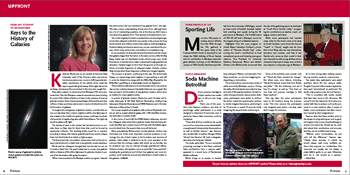KEYS TO THE HISTORY OF GALAXIES
 Katherine Rhode was an art student at Sonoma State University north of San Francisco when she took an introductory astronomy course to fulfill a general education requirement. As her artistic vision made the leap to appreciating the beauty of the night sky and its workings, she became the one student in the class who caught fire.
Katherine Rhode was an art student at Sonoma State University north of San Francisco when she took an introductory astronomy course to fulfill a general education requirement. As her artistic vision made the leap to appreciating the beauty of the night sky and its workings, she became the one student in the class who caught fire.
Now, with a master’s in astronomy from Wesleyan (’97) and a doctorate from Yale, this Wesleyan research associate has been hunting for some of the oldest collections of stars in the universe. Known as globular clusters, these massive assemblages of thousands and even millions of stars provide an astronomer’s version of a fossil record in the formation of galaxies.
To imagine the strangeness of globular clusters, consider that our own sun has fewer than a dozen neighbors within nine light years. A star located in the middle of a globular cluster could have hundreds of thousands of neighboring stars within that distance. The night sky would be ablaze with light.
The density of stars in the clusters has led astronomers to consider them as likely sites for black holes that could be formed by spectacular collisions. The resulting bodies would be so massive, according to theory, that intense gravitational forces would collapse them into black holes from which no light escapes.
The theory had only one problem: astronomers had not found unequivocal evidence for a black hole in any globular cluster anywhere.
Rhode and her colleagues changed that, but she had not set out to locate a black hole. Her goal instead was to survey nine galaxies within a distance of 60 million light years for globular clusters in pursuit of her fascination with galaxy formation.
“When I was a student in the Wesleyan master’s program, I learned that astronomers did not understand how galaxies form,” she says. “We have a basic understanding of how stars form, although there are a lot of outstanding questions, but at the time we didn’t have a clue about how galaxies form. That seemed so fundamental to me.”
The model of galaxy formation prevalent then envisioned giant gas clouds that collapsed under their own gravity, in the process forming the thousands and millions of stars that make up individual galaxies. Students taking introductory astronomy courses read about this process, which many astronomers now believe is completely wrong.
An accumulation of observational and theoretical work has shown that galaxies began their formation in the early universe. After the Big Bang, matter was not distributed evenly—think lumpy soup. Small fluctuations in density led to matter coalescing through gravitational attraction. Galaxies began to form from the ground up through collisions of smaller fragments of collapsed matter. Globular clusters likely formed when these fragments collided and merged together.
The process is dynamic, continuing to this day. The Andromeda Galaxy, our nearest large spiral neighbor, is approaching us and will in some far distant time merge with the Milky Way. Meanwhile, the Milky Way is gobbling up a dwarf galaxy known as Sagittarius.
These collisions take place on a vast timescale and do not produce star-on-star smashes because interstellar distances are so great. But they can lead to the formation of new globular clusters, which serve as markers for major galactic events.
In pursuit of globular clusters, Rhode has used 3.5-meter and 4-meter telescopes at Kitt Peak National Observatory, orbiting X-ray telescopes (Chandra Observatory and XMM-Newton), and a 10-meter telescope on Mauna Kea in Hawaii.
Her survey revealed spiral galaxies with as few as 80 globular clusters as well as a giant elliptical galaxy with 1,500 identified clusters; she estimates it contains 5,000.
In the course of work with the XMM-Newton telescope, she and her colleagues determined that a globular cluster that she had previously identified was a potent source of X-rays with the telltale signature of a black hole. She expects that more will be found.
More speculatively, Rhode points out that globular clusters may illuminate one of the most important unsolved problems in cosmology: the role of dark matter in the formation and structure of galaxies. Dark matter is believed to be far more prevalent in the universe than the ordinary matter with which we are familiar, but its existence can only be inferred through gravitational effects. Globular clusters, she explains, serve as point-like “tracer particles” revealing the gravitational pull of their host galaxies and, most important, could reveal the amount and distribution of dark matter in the galaxies.
